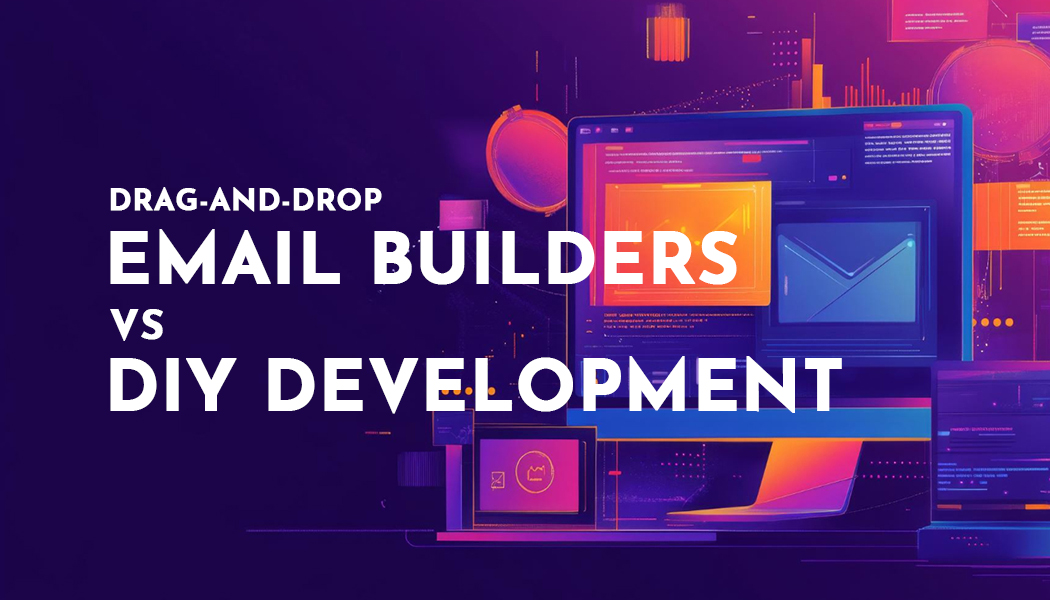Drag-and-Drop Email Builders vs DIY Development: Pros and Cons
Introduction
In the world of email marketing, creating effective and visually appealing campaigns is key to engaging audiences and driving results. Businesses and marketers often face a fundamental choice in their email-building approach: using drag-and-drop email builders or opting for custom-coded emails. Each method offers distinct advantages and challenges, making it crucial to understand which one aligns best with a brand's specific needs. This article explores the pros and cons of drag-and-drop email builders and DIY (do-it-yourself) development, providing insights into the strengths, limitations, and ideal use cases for each approach. Whether you prioritize ease of use or seek complete customization, understanding these options will help you make an informed decision for your next email campaign.
Why Choose Drag-and-Drop Email Builders?
Drag-and-drop email builders make creating professional-looking emails quick and easy, even for those without technical skills. These tools, like Mailchimp, Mailjet, and Constant Contact, allow users to build emails by simply dragging elements like text, images, buttons, and placing them where needed. The best part is that you don't have to know any coding languages like HTML or CSS.
These platforms often include pre-made email templates that can be easily customized to suit your brand's style and messaging. For example, if you're running a small business or a non-profit organization, you might need to send out newsletters regularly but don't have the time or resources to hire a developer. A drag-and-drop tool helps you get your message out quickly while maintaining a professional appearance.
However, this simplicity comes with some trade-offs. Since drag-and-drop editors use pre-designed blocks, there are limits to how much you can customize. For instance, if you have a specific design vision or want to create a unique interactive element, you may find yourself restricted by the template's structure. Additionally, such emails can sometimes face issues with rendering perfectly across all devices and email clients.
Overall, drag-and-drop email builders are ideal for those who prioritize speed and ease of use over extensive customization, making them a great choice for businesses looking to get campaigns up and running without needing coding skills. While they may not offer the same level of flexibility as custom email template design, they provide a valuable tool for creating professional-looking emails quickly and efficiently.
Why Choose DIY Email Development?
DIY email development involves creating emails from scratch using coding languages like HTML and CSS. This approach is best suited for those who want complete control over their email design and functionality. For example, if a company wants to create a custom interactive email with unique animations or personalized layouts, coding is the way to go. Developers can build anything from custom headers to unique layouts, giving businesses a distinct look that aligns perfectly with their brand.
A good example of this approach is when a company needs to send emails that perfectly align with their website's design or include advanced interactive elements like sliders or embedded forms. These features may not be possible using drag-and-drop builders, but with custom coding, they can be implemented exactly as desired. Developers can ensure emails look consistent across various devices and email clients by testing and tweaking the code.
However, the DIY approach can be time-consuming and requires technical expertise. It may also demand more resources, like hiring a skilled developer or dedicating time to learning how to code. For example, a small business owner without a coding background may struggle to make simple design adjustments, which would be much easier with a drag-and-drop editor.
Ultimately, DIY email development is perfect for those who value flexibility and precision over speed, allowing for fully customized emails that can help a brand stand out.
Balancing Between Drag-and-Drop and DIY Development
Some businesses find that a hybrid approach works best, using both drag-and-drop email builders and DIY coding. This approach allows users to take advantage of the speed and simplicity of drag-and-drop tools, while still having the flexibility to tweak and customize using code when needed.
For example, a marketing team might use a drag-and-drop builder like Mailchimp to quickly create a newsletter, choosing from ready-made templates and adding content with ease. But if they want to include a unique feature, such as a custom countdown timer for a sale or a specific style that matches their brand, they can insert custom HTML or CSS code into the email template.
Another example is when companies need to ensure that their emails look perfect across all email clients and devices. A drag-and-drop builder might get them most of the way there, but adding some custom code can fix alignment issues or adjust styles that don't look right on certain devices.
This combined approach offers a middle ground, making it possible for companies to launch email campaigns quickly while still having the power to make adjustments when necessary. It’s especially useful for small businesses or teams that don’t have the time to code everything from scratch but still want some control over the design. It allows them to save time and money without sacrificing the professional look they aim for.
Conclusion: Choosing the Right Email Building Approach
In the realm of email marketing, the decision between drag-and-drop email builders and DIY development hinges on a brand's unique needs and priorities. Drag-and-drop builders offer a user-friendly and time-efficient solution for those seeking quick and professional results without coding knowledge. However, for businesses that require extensive customization, advanced interactive elements, or a unique brand identity, DIY development using HTML and CSS provides greater flexibility and control.
When considering your email building approach, carefully evaluate your team's technical expertise, the complexity of your campaigns, and the level of customization required. For businesses with limited resources or a desire for a rapid turnaround, drag-and-drop builders can be a valuable tool. On the other hand, if you prioritize complete control over your email design and functionality, DIY development may be the more suitable option.
Ultimately, the most effective approach may involve a combination of both methods. By leveraging the strengths of drag-and-drop builders for core email construction and supplementing with custom coding for specific elements, businesses can achieve a balance of speed, ease of use, and customization. This hybrid approach can be particularly beneficial for teams that want to maintain a professional email aesthetic while also ensuring flexibility and alignment with their brand's unique identity.
Remember, the key to successful email marketing lies not only in the choice of tools but also in the quality of your content and effective audience segmentation. By selecting the right email building approach and focusing on creating engaging and personalized campaigns, you can drive higher open rates, click-through rates, and ultimately achieve your marketing goals.




